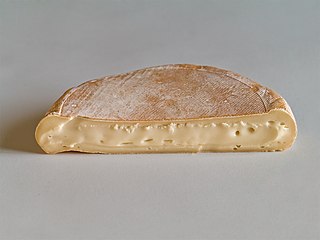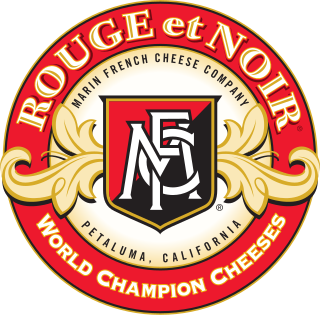
Brie is a soft cow's-milk cheese named after Brie, the French region from which it originated. It is pale in color with a slight grayish tinge under a rind of white mould. The rind is typically eaten, with its flavor depending largely upon the ingredients used and its manufacturing environment. It is similar to Camembert, which is native to a different region of France. Brie typically contains between 60% and 75% butterfat, slightly higher than Camembert.

Roquefort is a sheep milk cheese from Southern France, and is one of the world's best known blue cheeses. Though similar cheeses are produced elsewhere, EU law dictates that only those cheeses aged in the natural Combalou caves of Roquefort-sur-Soulzon may bear the name Roquefort, as it is a recognised geographical indication, or has a protected designation of origin.

Stilton is an English cheese, produced in two varieties: Blue, which has Penicillium roqueforti added to generate a characteristic smell and taste, and White, which does not. Both have been granted the status of a protected designation of origin (PDO) by the European Commission, requiring that only such cheese produced in the three counties of Derbyshire, Leicestershire and Nottinghamshire may be called Stilton. The cheese takes its name from the village of Stilton, now in Cambridgeshire, where it has long been sold.

Caerphilly is a hard, crumbly white cheese that originated in the area around the town of Caerphilly, Wales. It is thought to have been created to provide food for the local coal miners. The Caerphilly of that period had a greater moisture content, and was made in local farms. At the start of the 20th century, competition for milk in the local area saw production decline, and Caerphilly production was gradually relocated to England.

Oka is a semi-soft washed rind cheese that was originally manufactured by Trappist monks located in Oka, Quebec, Canada. The cheese is named after the town. It has a distinct flavour and aroma, and is still manufactured in Oka, although now by a commercial company. The recipe was sold in 1981 by Les Pères Trappistes to the Agropur cooperative.

Goat cheese, or chèvre, is cheese made from goat's milk. Goats were among the first animals to be domesticated for producing food. Goat cheese is made around the world with a variety of recipes, giving many different styles of cheese, from fresh and soft to aged and hard.

Camembert is a moist, soft, creamy, surface-ripened cow's milk cheese. It was first made in the late 18th century in Camembert, Normandy, in northwest France. It is sometimes compared in look and taste to brie cheese, albeit with a slightly lower butterfat content than brie's typical 60% and 75% by weight.

Reblochon is a soft washed-rind and smear-ripened French cheese made in the Alpine region of Haute-Savoie from raw cow's milk. It has its own AOC designation.

Gubbeen Cheese is a surface ripened, semi-soft, cow's milk cheese with a pink and white rind. The flavours are creamy with mushroom and nutty aftertastes but vary depending on maturity of cheese. Gubbeen Farmhouse Products also produce a Smoked Gubbeen.

Stinking Bishop is a washed-rind cheese produced since 1972 by Charles Martell and Son at Hunts Court Farm, Dymock, Gloucestershire, in the west of England. It is made from the milk of Gloucester cattle.

Coulommiers is a soft ripened cheese from Coulommiers, Seine-et-Marne, France. It is made from cow's milk, and is usually in the shape of a disc with white, bloomy, edible Penicillium candidum rind. When produced as an artisanal or "farmhouse" cheese from unpasteurized milk, it has some reddish blush in parts of the rind. The period of ripening when made of pasteurised whole milk is about four to six weeks. The fat content is 40 per cent.

Maroilles is a cow's-milk cheese made in the regions of Picardy and Nord-Pas-de-Calais in northern France. It derives its name from the village of Maroilles in the region in which it is still manufactured.

There are many different types of cheese. Cheeses can be grouped or classified according to criteria such as length of fermentation, texture, methods of production, fat content, animal milk, and country or region of origin. The method most commonly and traditionally used is based on moisture content, which is then further narrowed down by fat content and curing or ripening methods. The criteria may either be used singly or in combination, with no single method being universally used.

Beecher's Handmade Cheese is an artisan cheesemaker and retail shop with locations in the Pike Place Market, Seattle, Washington and New York City's Flatiron District. The company was founded by Kurt Beecher Dammeier in 2003 and opened in the Pike Place Market after Dammeier obtained a difficult to obtain storefront lease in the Market. Because Dammeier had never been a cheesemaker, he sought out the assistance of Brad Sinko, who helped run a family cheese-making business in Oregon. A second location was opened in 2011 in the Flatiron neighborhood of Manhattan in New York City.
Artisanal cheese refers to cheeses produced by hand using the traditional craftsmanship of skilled cheesemakers. As a result, the cheeses are often more complex in taste and variety. Many are aged and ripened to achieve certain aesthetics. This contrasts with the more mild flavors of mass-produced cheeses produced in large-scale operations, often shipped and sold right away.

The Marin French Cheese Company is a manufacturer of artisan cheese located in rural west Marin County, California. The company was founded in 1865 by Jefferson Thompson, and produces cheeses under the Marin French Cheese brand name. It is the oldest continually operating cheese manufacturer in the United States.

Limburger is a cheese that originated in the Herve area of the historical Duchy of Limburg, which had its capital in Limbourg-sur-Vesdre, now in the French-speaking Belgian province of Liège. The cheese is especially known for its strong smell caused by the bacterium Brevibacterium linens.















